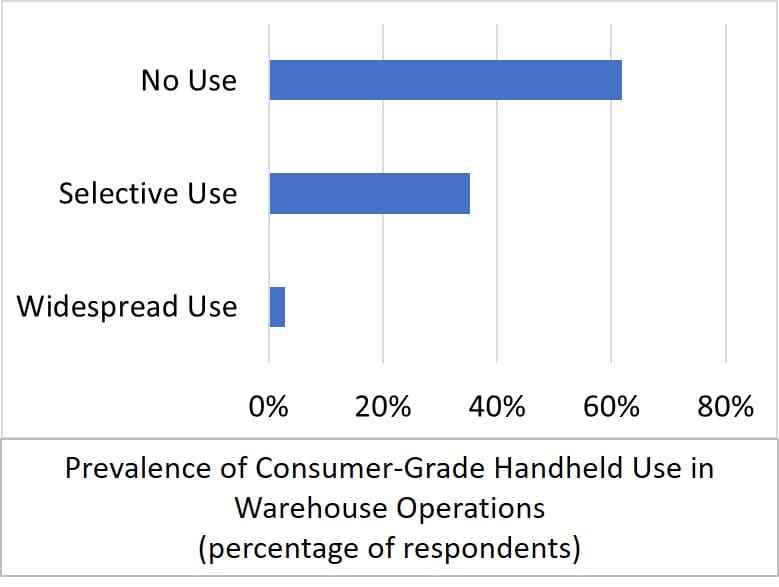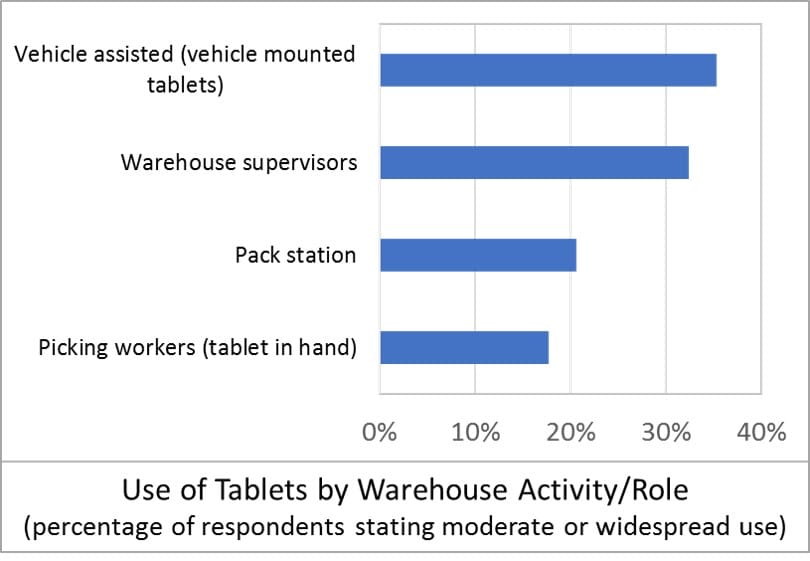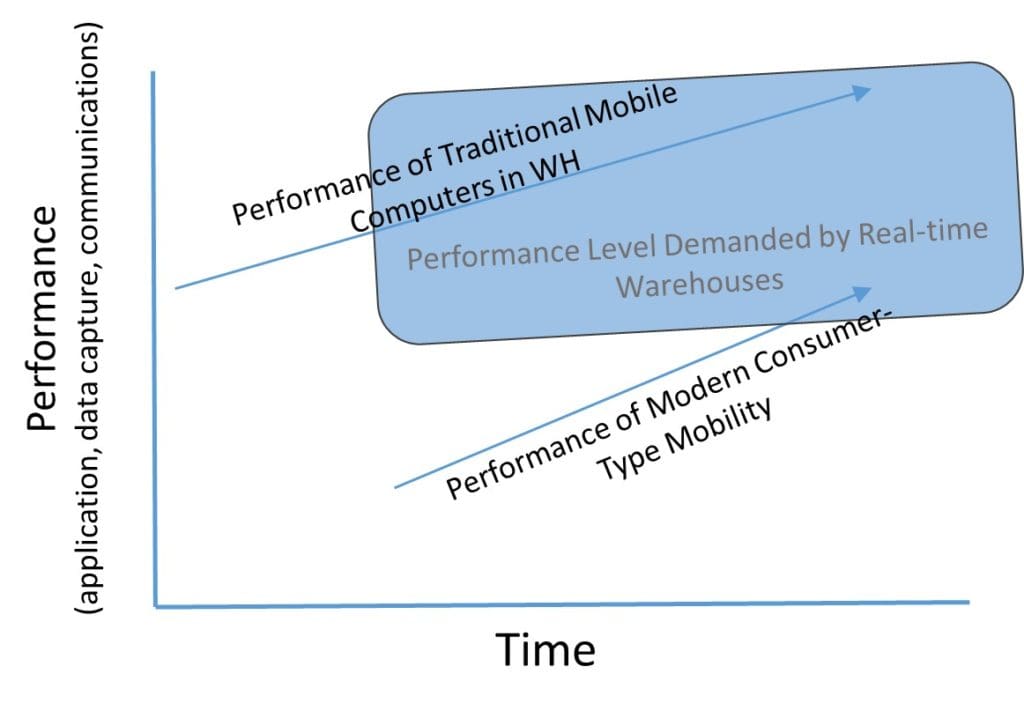ARC Advisory Group and DC Velocity magazine recently concluded a web survey on the current use and future plans for mobile computing in the warehouse. Detailed findings from the research will be published soon. However, I would like to take this opportunity to discuss the results from a small subset of the research – namely the use of consumer-grade mobility in the warehouse.
Consumer Devices are Affordable and Intuitive
The use of Android-based devices in the warehouse is no longer an emerging practice. The Android operating system is running smartphones across the globe, and leading handheld providers such as Zebra and Honeywell now offer a number of ruggedized devices that run on Android as well. But only 2 years ago this wasn’t the case. It was a novel practice back then and it was primarily seen as an intuitive option that would enable new workers to get up-to-speed and productive as soon as possible. At the time, I wrote about SingPost’s development of a warehouse app to run on consumer-grade Android devices for use by new hires and temporary workers. This solution provided notable benefits to the company’s e-commerce fulfillment operations. Namely, it reduced employee training times due to the intuitive nature of the user interface and it also reduced IT costs due to the low price point of consumer devices that the company was able to utilize for picking tasks. The device set-up wasn’t ideal for all workers but well-suited for certain operations. This case and some other examples piqued my interest in determining the degree to which consumer-grade device use in warehouses had expanded over the last two years.
Prevalence of Consumer-Grade Device Usage
 In our recently completed survey, only 3 percent of respondents stated that use of consumer-grade handhelds is widespread in their warehouse operations. Meanwhile, 35 percent indicated that they use these devices selectively and 62 percent stated that they do not equip warehouse workers with consumer-grade mobile devices. These results were in line with what I expected – namely that consumer-grade devices are used selectively to supplement the primary devices used at the facility. More specifically, I expected respondents to use these devices to equip seasonal or other new workers. We tested this assumption by directly asking survey participants about their approach to equipping temporary warehouse workers during periodic volume increases such as peak holiday season. The results from this inquiry did not meet my expectations. Our results indicated that warehouses often have excess legacy rugged devices in stock and deploy them when needed to support seasonal warehouse labor surges. One respondent from a 3PL simply stated, “We have an excess of old units that we use when necessary.” And for those organizations that did purchase or lease devices to equip temporary workers, high-performance devices were still more frequently chosen than consumer-grade devices. These responses reinforce a theme reflected in many other parts of this survey – warehouses are resistant to change in their technology platform and when change does occur, it will likely be done incrementally. In contrast to handhelds, tablet usage in the warehouse does not have to overcome the inertia of legacy technology.
In our recently completed survey, only 3 percent of respondents stated that use of consumer-grade handhelds is widespread in their warehouse operations. Meanwhile, 35 percent indicated that they use these devices selectively and 62 percent stated that they do not equip warehouse workers with consumer-grade mobile devices. These results were in line with what I expected – namely that consumer-grade devices are used selectively to supplement the primary devices used at the facility. More specifically, I expected respondents to use these devices to equip seasonal or other new workers. We tested this assumption by directly asking survey participants about their approach to equipping temporary warehouse workers during periodic volume increases such as peak holiday season. The results from this inquiry did not meet my expectations. Our results indicated that warehouses often have excess legacy rugged devices in stock and deploy them when needed to support seasonal warehouse labor surges. One respondent from a 3PL simply stated, “We have an excess of old units that we use when necessary.” And for those organizations that did purchase or lease devices to equip temporary workers, high-performance devices were still more frequently chosen than consumer-grade devices. These responses reinforce a theme reflected in many other parts of this survey – warehouses are resistant to change in their technology platform and when change does occur, it will likely be done incrementally. In contrast to handhelds, tablet usage in the warehouse does not have to overcome the inertia of legacy technology.
Tablet Usage in the Warehouse
 Tablets, such as the iPad and similar devices running Android or Microsoft operating systems, have experienced exceptional growth in consumer and business use. The warehouse also has use cases for tablets. Most notably, WMS providers such as Manhattan Associates, JDA Software, and HighJump have developed applications for supervisors or consultants to use on tablets while roaming the warehouse floor. We asked logistics professionals to indicate the degree to which certain categories of warehouse workers in their organizations were utilizing tablets. Surprisingly, vehicle mounted tablets (ie forklifts) was the most prevalent use case, followed by warehouse supervisors, pack stations, and finally picking tasks. One respondent commented that workers at his company are using Microsoft Surface devices for their vehicle-mounted tablets and have had zero damaged units over 2 years. We followed-up with a question on anticipated change in tablet usage over the next three years. Over 60 percent of respondents indicated that they expect supervisor use to increase. Surprisingly, over 40 percent expect use of tablets to increase for the picking function. Finally, over 30 percent of respondents expected increase use of tablets at, pack stations and on vehicle assisted/mounted use cases.
Tablets, such as the iPad and similar devices running Android or Microsoft operating systems, have experienced exceptional growth in consumer and business use. The warehouse also has use cases for tablets. Most notably, WMS providers such as Manhattan Associates, JDA Software, and HighJump have developed applications for supervisors or consultants to use on tablets while roaming the warehouse floor. We asked logistics professionals to indicate the degree to which certain categories of warehouse workers in their organizations were utilizing tablets. Surprisingly, vehicle mounted tablets (ie forklifts) was the most prevalent use case, followed by warehouse supervisors, pack stations, and finally picking tasks. One respondent commented that workers at his company are using Microsoft Surface devices for their vehicle-mounted tablets and have had zero damaged units over 2 years. We followed-up with a question on anticipated change in tablet usage over the next three years. Over 60 percent of respondents indicated that they expect supervisor use to increase. Surprisingly, over 40 percent expect use of tablets to increase for the picking function. Finally, over 30 percent of respondents expected increase use of tablets at, pack stations and on vehicle assisted/mounted use cases.
Final Word
Overall, these findings indicate that I previously underestimated the value of having ruggedized handheld devices in the warehouse. In contrast, tablets do not have the same propensity to damage and also do not have the same history of warehouse usage as handhelds. Therefore, there is less resistant to these new devices being adopted for new roles such as supervisory, consulting, or even as an interface between robots and warehouse workers.
















 Today’s digital culture has put tremendous pressure on distribution centers (DC) and warehouses, forcing them to drastically increase their pace of fulfillment to meet growing consumer expectations. This 24/7 ecommerce-driven industry transformation is causing greater peaks in demand that stretch equipment and people like never before. The impact of these peaks can have a domino effect through the supply chain – from DCs, to suppliers, to manufacturers and everyone in between.
Today’s digital culture has put tremendous pressure on distribution centers (DC) and warehouses, forcing them to drastically increase their pace of fulfillment to meet growing consumer expectations. This 24/7 ecommerce-driven industry transformation is causing greater peaks in demand that stretch equipment and people like never before. The impact of these peaks can have a domino effect through the supply chain – from DCs, to suppliers, to manufacturers and everyone in between.
